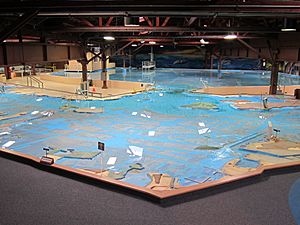U.S. Army Corps of Engineers Bay Model facts for kids

View of the San Francisco Bay portion of the Bay Model.
|
|
| Lua error in Module:Location_map at line 420: attempt to index field 'wikibase' (a nil value). | |
| Established | 1957 |
|---|---|
| Location | 2100 Bridgeway, Sausalito, California |
| Key holdings | Hydraulic model of the San Francisco Bay and Sacramento–San Joaquin River Delta |
| Owner | US Army Corps of Engineers, San Francisco District |
| Public transit access | Golden Gate Transit, bus routes 2, 4, 30, or 92; or Golden Gate Ferry from San Francisco |
The U.S. Army Corps of Engineers Bay Model is a huge working hydraulic scale model. It shows the San Francisco Bay and the Sacramento-San Joaquin River Delta System. This model is still working today. However, it is no longer used for scientific studies. Instead, it is open to the public. Visitors can explore educational exhibits about how water moves in the Bay. You can find the model at the Bay Model Visitor Center in Sausalito, California.
Contents
History of the Bay Model
In the late 1940s, a man named John Reber had an idea. He wanted to build two big dams in the San Francisco Bay. His goal was to provide more fresh water for people and farms. It would also connect local communities better.
Why the Model Was Built
In 1953, the U.S. Army Corps of Engineers decided to study Reber's plan in detail. Another person, Cornelius Biemond, suggested a similar idea. He proposed damming the Sacramento River to send fresh water through pipes. To test these big plans, construction of the Bay Model began. It was finished in 1957. Tests on the model showed that Reber's plan would not work. So, the idea was stopped.
Expanding the Model
Later, between 1966 and 1969, more parts were added to the model. This new section showed the Sacramento-San Joaquin River Delta. It helped scientists study how deeper shipping channels might affect water quality. They also looked at how changing river paths would impact the water. Once finished, the expanded model covered about 2 acres of land.
Size and Features of the Model
The Bay Model is truly massive. It measures about 320 feet long from north to south. From east to west, it is about 400 feet long.
How the Model is Built
The model is made from 286 large concrete slabs. Each slab weighs about five tons. They fit together like a giant jigsaw puzzle. The model includes everything that affects water flow in the Bay and Delta. This includes shipping channels, rivers, creeks, and canals. It also shows wharfs, piers, dikes, bridges, and breakwaters.
Areas Represented in the Model
The model covers a huge area of California. It starts in the Pacific Ocean, extending 17 miles past the Golden Gate. It includes the San Francisco Bay, San Pablo Bay, and Suisun Bay. The model also shows all of the Sacramento-San Joaquin River Delta. This goes as far north as Verona, near Sacramento. To the south, it reaches Vernalis, near Stockton on the San Joaquin River.
Understanding the Model's Scale
The Bay Model uses different scales for its size and time. This helps it work like the real Bay.
Horizontal and Vertical Scale
The model's horizontal scale is 1:1000. This means that 1 foot on the model represents 1000 feet in the real world. The vertical scale is 1:100. So, 1 foot of height on the model represents 100 feet in reality.
Time Scale and Distortion
The model also operates on a time scale of 1:100. This means that 1 hour in the model is like 100 hours in the real Bay. You might notice the model looks a bit stretched vertically. This is called distortion. The vertical scale is ten times larger than the horizontal scale. This distortion is important. It helps the water flow correctly over the shallow areas of the model.
Correcting Water Flow
Even with the distortion, the water might flow too easily. To fix this, engineers use many small copper strips throughout the model. These strips help slow down the water flow. The exact number of copper strips is adjusted carefully. This makes sure the model accurately shows how water moves in the real San Francisco Bay.
Images for kids



